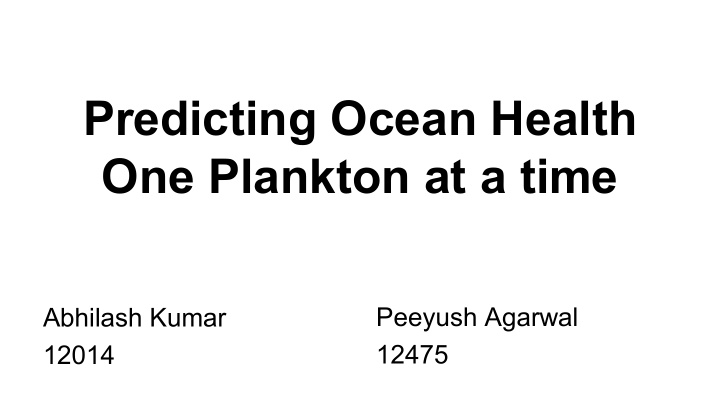



Predicting Ocean Health One Plankton at a time Abhilash Kumar Peeyush Agarwal 12014 12475
Motivation Critically important to our ecosystem - Represent the bottom few levels of food chain - Play an important role in ocean’s carbon cycle Population levels are an ideal measure of the health of world’s oceans and ecosystems
Traditional methods are - Time consuming - Cannot scale for large-scale studies Could take a year or more to manually analyze the imagery volume captured in a single day A better approach : - Use underwater imagery sensors for capturing images - Automated image classification using machine learning
Objective To create an algorithm that given an image, assigns class probabilities for various plankton classes.
Dataset Provided for Data Science Bowl competition Contains 121 Classes Consists of : - 30,000 labeled images - 130,000 test images
Challenges - Many different species with varying size - Image can have any orientation within 3-D space - Ocean replete with detritus that have no taxonomic identification - Sometimes difficult for even experts because of noise - Presence of "unknown" classes
Methodology
Computer Vision What we see What the computer sees
Feature Learning Representation Algorithm How to determine features given the image?
Features for vision SIFT GIST Domain specific hand engineered features like - Ratio of glob's width and height - Shape/Size
Learning the features! Using Neural Networks (Inspired by nature) One Learning Algorithm Hypothesis Neural Networks
Convolutional Neural Networks Neural Networks with : Local Connectivity Same weight for neurons in a depth slice
Layers used to build CNN
Convolutional Layer
Polling Layer Max Pool with 2x2 filters and stride 2
RELU Layer Apply elementwise activation function such as max(0,x) FC (i.e. Fully Connected) Layer As with ordinary Neural Networks and as the name implies, each neuron in this layer will be connected to all the numbers in the previous volume.
CNN Example Typical CNNs for vision look like - [CONV-RELU-POOL]xN,[FC-RELU]xM, SOFTMAX - [CONV-RELU-CONV-RELU-POOL]xN,[FC-RELU]xM,SOFTMAX
Work already done - Explored the dataset - Learnt to use AWS and used it to train a CNN - Read some theory - Tried Random Forest with hard coded features* * Used the getting started code available online
Future Work - Designing the Network - Preventing Overfitting - Data Augmentation - Dropouts - Benchmarking against SIFT
Why data augmentation?
References - Lecun Y. , Bottou L. , Bengio Y. , Haffner P. Gradient-based learning applied to document recognition. Proceedings of the IEEE, 86(11),2278 - 2324,1998 - Krizhevsky, Alex, Ilya Sutskever, and Geoffrey E. Hinton. Imagenet classification with deep convolutional neural networks. Advances in neural information processing systems. 2012. - Andrew Ng's Deep Learning Lectures http://cs229.stanford.edu/materials/CS229-DeepLearning.pdf - CS231n : CNN for Visual Recognition Lectures http://vision.stanford.edu/teaching/cs231n/index.html
Questions?
Recommend
More recommend